
Discover the Orange Garden Rome: Practical Info, Parco Savello Opening Hours & How to Get There
If you’re searching for a peaceful escape in Rome, away from the crowds but with a spectacular view, look no further than the Orange Garden in Rome (Giardino degli Aranci or Parco Savello). Tucked away on the Aventine Hill, and located in Italy’s capital city, this charming little park is one of the Eternal City’s best-kept secrets. As you wander through, the fragrance of orange trees mingles with a breathtaking panorama of St. Peter’s dome and the rooftops of Rome.
Both locals and travelers adore this spot: it’s ideal for a romantic stroll at sunset, a quick photo stop during your sightseeing, or simply a moment to pause and breathe in the shade of the orange trees.
But before you head there, you’re probably asking yourself: What are the Orange Garden Rome opening hours? How do you get to Parco Savello? And what else is there to see nearby, like the famous Orange Garden keyhole with its magical optical illusion?
That’s exactly what this guide is here for. I’ll share all the essential tips for visiting the Orange Garden in Rome: how to get there without hassle, the opening times, the fascinating history behind the park, and the must-see sights around it. In short, everything you need to enjoy this hidden gem in the heart of Rome to the fullest.
Contents
- 1 What is the Orange Garden in Rome?
- 2 Where is the Orange Garden in Rome and How to Get There?
- 3 Orange Garden Rome Opening Hours
- 4 Best Time to Visit the Orange Garden in Rome
- 5 What to See in the Orange Garden in Rome
- 6 The History of the Orange Garden in Rome (Parco Savello)
- 7 Must-See Places Near the Orange Garden in Rome
- 8 FAQ about the Orange Garden in Rome
What is the Orange Garden in Rome?
The orange garden stands as a testament to Rome’s rich history and geography, occupying the site of the medieval Savelli family’s fortress and offering a unique perspective over the city.
Chances are you’ve already seen photos of the famous Orange Garden in Rome on Instagram or Pinterest: a central avenue framed by perfectly trimmed orange trees, drawing your eyes straight toward a panoramic terrace with a splendid view of the Eternal City.
In Italian, this little haven is called the Giardino degli Aranci, though its official name is Parco Savello. Still, for locals, it’s the orange trees that define the garden’s identity and give it its unmistakable charm.
Perched on the Aventine Hill, one of Rome’s legendary seven hills, the garden stretches over about 8,000 square meters. That might seem modest compared to vast parks like Villa Borghese, but what it lacks in size, it more than makes up for in beauty, atmosphere, and soul.
The Orange Tree Garden in Rome is loved equally by Romans and travelers. Families come here for weekend strolls, couples wander hand in hand at sunset, and photographers can’t resist its endless inspiration. It’s both a peaceful retreat from the city’s hustle and a must-visit lookout with one of the best panoramic views of Rome.
What makes this garden truly unique is the way nature, history, and spirituality come together. The orange trees recall the Dominican heritage, the terrace overlooks centuries of Roman architecture, and the medieval walls of Parco Savello instantly transport you back in time. The garden’s symmetrical plan, with its balanced layout and central avenue, enhances both its aesthetic appeal and the experience of its vistas. From the moment you walk through its gates, you know you’ve stepped into a place apart.

Where is the Orange Garden in Rome and How to Get There?
The Orange Garden in Rome is perched at the top of the Aventine Hill, in the Aventino/Testaccio neighborhood.
- Official address: Piazza Pietro d’Illiria, 00153 Rome. This is the present location of the Orange Garden, making it easily accessible for visitors.
This is the main entrance to Parco Savello, but if you’re wandering through the Aventine area, you’ll also spot plenty of signs pointing you toward the Giardino degli Aranci.
Nearby, you can admire the historic building of the Basilica of Santa Sabina, which adds to the architectural charm of the area.
Here are the easiest ways to reach it:
By Metro
The quickest way is to take line B of the Rome metro and get off at Circo Massimo station. From there, it’s about a 5–10 minute uphill walk to Parco Savello.
The climb may feel a bit steep if you haven’t had your morning espresso yet, but it’s short and the stunning panoramic view of Rome at the top makes it absolutely worth it.
By Bus
Rome’s bus network is excellent, and several lines stop close to the Orange Garden, including: 23, 30, 44, 81, 130, 160, 170, 280, 628, 716, and 781.
With so many options, it’s an easy choice if you’re coming from a different neighborhood outside Rome's historic center.
By Tram
You can also hop on tram line 3, which crosses much of the city and leaves you within walking distance of the Aventine Hill.
On Foot
If you’re already in the city center, walking is a great option. Head up from the banks of the Tiber River (Lungotevere Aventino) and you’ll pass through the Municipal Rose Garden of Rome. In spring, when over 1,000 rose varieties are in bloom, this detour makes your walk even more magical, before arriving at the peaceful Orange Garden.
The area near the Rose Garden was once home to the historic cattle market (Campo Vaccino), adding a layer of ancient Roman history to your route. If you’re interested in venturing further, consider exploring some of the best day trips from Rome.
Orange Garden Rome Opening Hours
Good news: entry to the Orange Garden in Rome is completely free. You can visit as many times as you like during your trip! Just note that Parco Savello isn’t open 24/7, so you’ll need to plan around the official schedule.
Here are the official opening hours of the Orange Garden in Rome (which vary by season):
- October to February: 7:00 AM – 6:00 PM
- March and September: 7:00 AM – 8:00 PM
- April to August: 7:00 AM – 9:00 PM
Period | Opening hours |
October to February | 7:00 AM – 6:00 PM |
March and September | 7:00 AM – 8:00 PM |
April to August | 7:00 AM – 9:00 PM |
⚠️Important: the gates close exactly on time. If you show up at the last minute, you’ll likely be turned away.
- Accessibility: The main entrance on Piazza Pietro d’Illiria is fully accessible for both strollers and wheelchairs.
- Facilities: There are no restrooms or cafés inside Parco Savello, so make sure to plan ahead. That said, the shady benches under the orange trees are perfect for a quick rest or a quiet picnic.
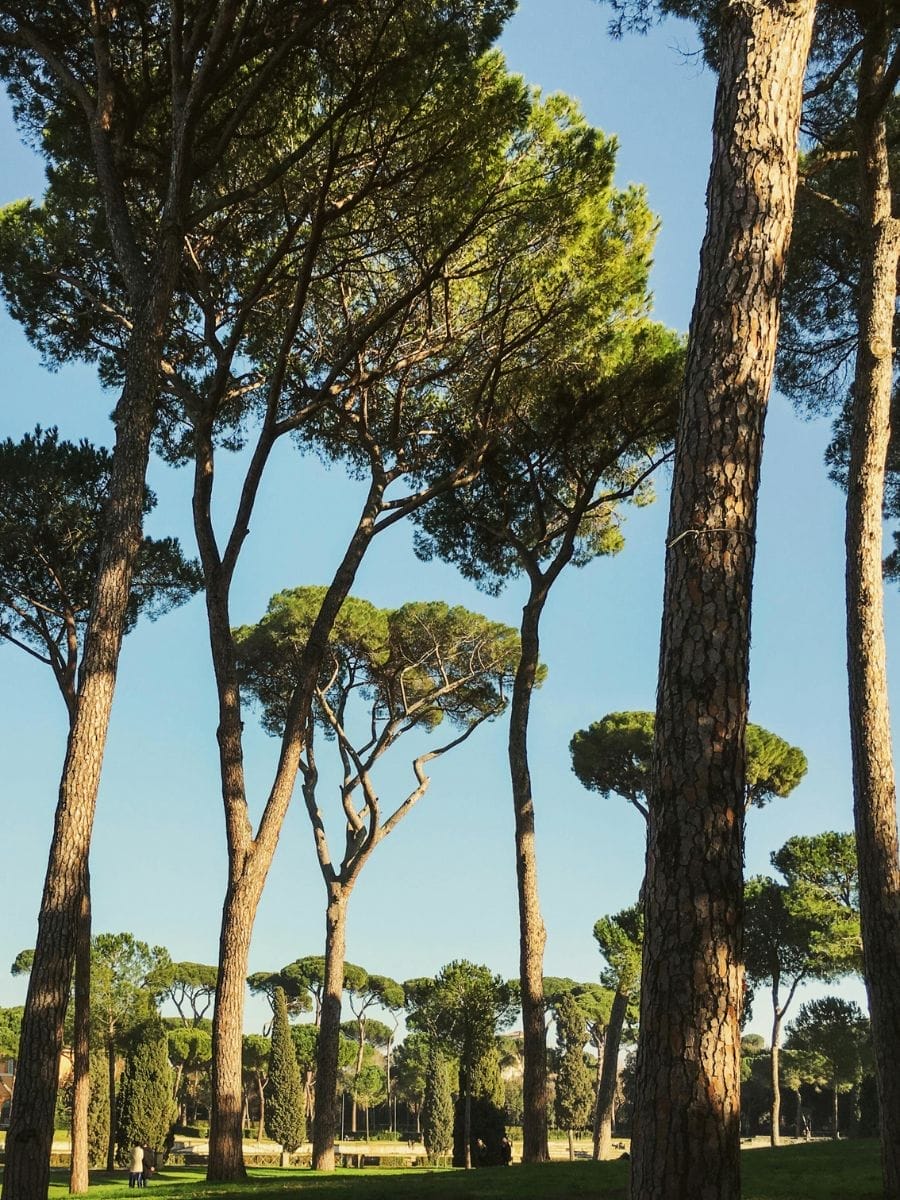
Best Time to Visit the Orange Garden in Rome
- Early morning: The best time if you want to soak up the peaceful atmosphere and snap photos of the Orange Garden in Rome without the crowds. If you’re lucky, you may even have the park almost entirely to yourself.
- Late afternoon / sunset: This is the most magical time of day. As the sun dips low, Rome’s domes and rooftops take on a golden glow, creating postcard-worthy views. It’s also when locals come to unwind, giving the park a relaxed, friendly vibe.
Insider tip: Combine your visit with the famous Knights of Malta Keyhole just a few steps away. Seeing both back-to-back is a classic, and very romantic, way to end your day in Rome.
What to See in the Orange Garden in Rome
The Orange Garden in Rome (also known as Savello Park) may not be large, but it’s packed with charm and little details worth noticing. As you wander along its symmetrical paths, you’ll discover much more than just a park: it’s a true belvedere offering one of the most breathtaking views of the Eternal City.
The visual impact of this panorama is striking, it never fails to wow visitors. From this elevated perch on the Aventine Hill, you can admire Rome from unique angles, with a perspective that captures some of its most iconic monuments, including Peter's Basilica and Piazza Venezia.
The Central Promenade
Step through the entrance at Piazza Pietro d’Illiria, and you’ll be welcomed by a wide central avenue lined with orange trees.
In spring, the air is filled with the intoxicating scent of orange blossoms, making the walk unforgettable. This elegant path leads straight to the panoramic terrace, the beating heart of the garden and its most photographed spot.
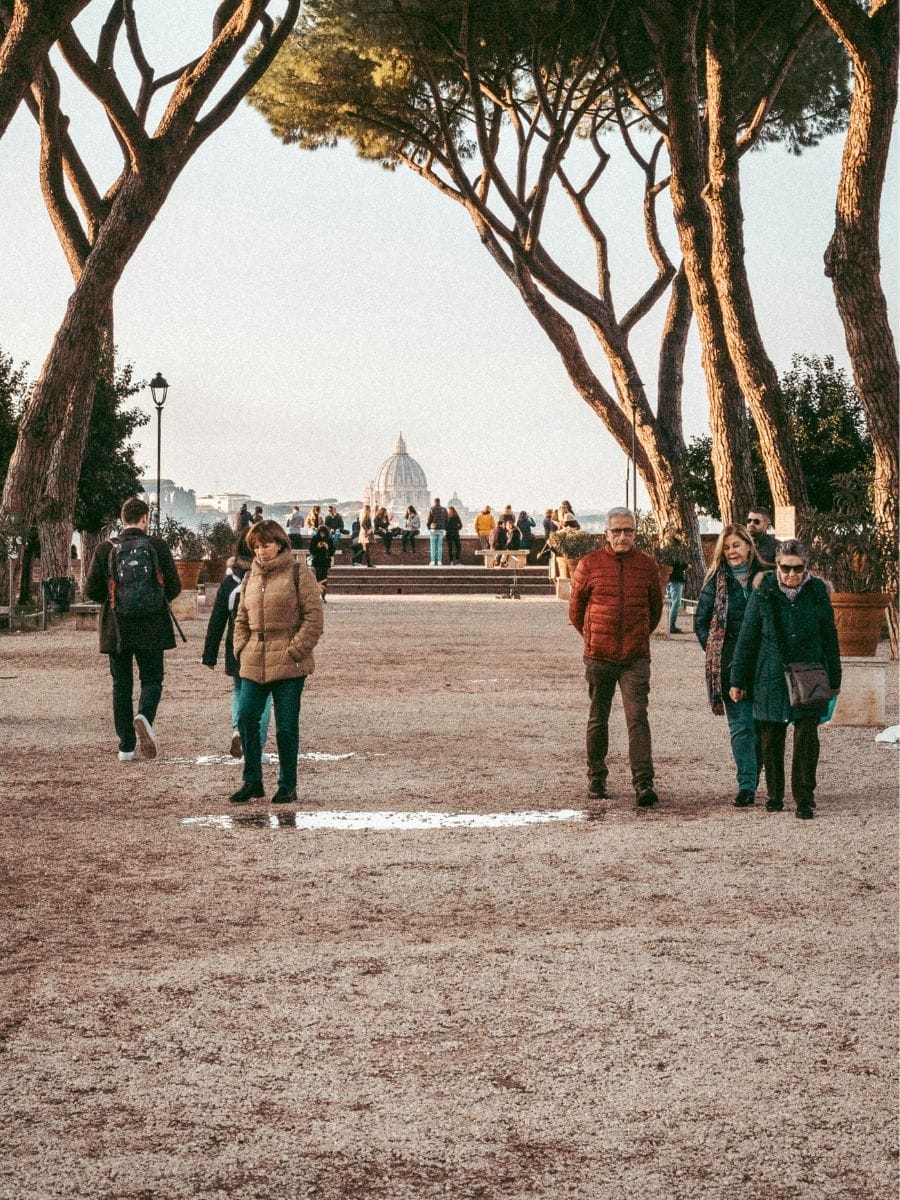
The Remains of the Savelli Fortress
As you explore the park, take a look at the medieval walls still enclosing the space. This part of Aventine Hill was once the site of an ancient fortress. The ancient fortress built by the Savelli family in the 13th century forms the historical foundation of the park.
On the side opposite Santa Sabina, you can still spot the outlines of square towers and even traces of the old drawbridge. The Savelli family constructed and owned this fortress, and their influence is still visible in the remnants of the medieval structure.
It’s a fascinating reminder of how layers of history coexist here, medieval fortifications blending seamlessly with the tranquil atmosphere of a romantic garden.
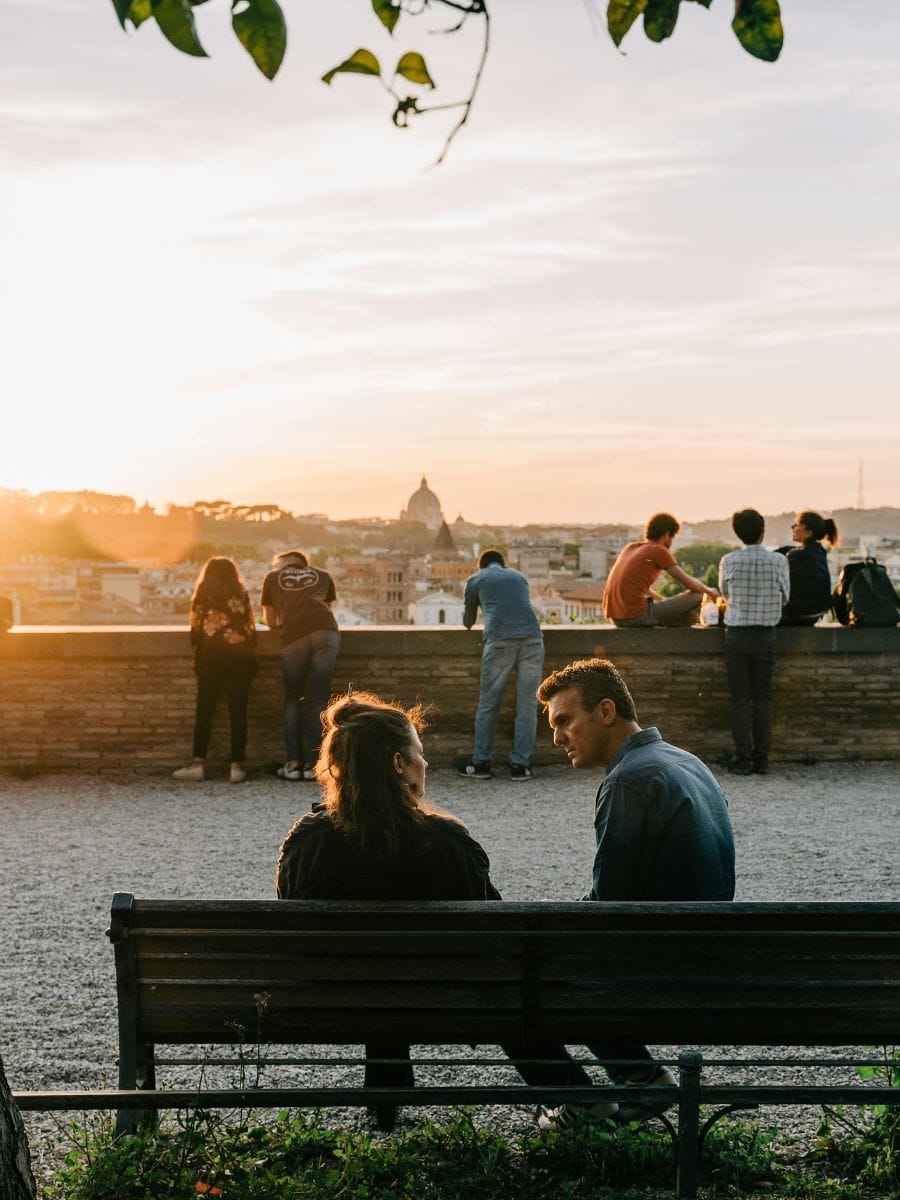
The Fountain on Piazza Pietro d’Illiria
Right at the main entrance stands a curious little fountain that tells a story of recycled history. It was built in the 1930s from two remarkable pieces:
- a granite bathtub from ancient Egypt, once reused in the Campo Vaccino (an old name for the Roman Forum),
- and a central marble mask, a decorative element designed in the 16th century by Giacomo della Porta.
The marble mask and other sculptural features were used to decorate and adorn the fountain, emphasizing its artistic and historical value.
Together, they create an eclectic fountain that feels like a miniature timeline of Rome’s layered past.
The Panoramic Terrace: The Star of the Show
The real highlight of the Orange Garden is, of course, its panoramic terrace. Thanks to its strategic spot on the Aventine Hill, the view from Parco Savello is one of the most spectacular in Rome:
- Straight ahead, the majestic dome of St. Peter’s Basilica dominates the skyline.
- To the right, you can make out the Tiber Island and the Great Synagogue of Rome.
- In the distance, the Janiculum Hill and Monte Mario frame the horizon.
- Just below, the Tiber River snakes its way past the old port of San Michele.
Tip – It’s the perfect place to pull out your camera or smartphone. Trust me, photos of the Orange Garden in Rome never disappoint, especially at sunset when the city glows in shades of pink, orange, and gold.

The History of the Orange Garden in Rome (Parco Savello)
The Orange Garden in Rome, also known as Parco Savello, is far more than just a pretty terrace with a view. Like many places in the Eternal City, it hides a fascinating past where legends, medieval fortresses, and urban transformations all come together.
Much of the original medieval fortress on this site was completely demolished in the 17th century, leaving only a few remnants. Today, some warehouses underground still exist as traces of the fortress beneath the park’s landscaped areas.
Medieval Origins
This peaceful spot wasn’t always a garden. In the 10th century, the powerful Crescenzi family built a fortress here, perched on the Aventine Hill. By the 13th century, the property had passed to the Savelli, one of Rome’s most influential aristocratic dynasties.
From their castle, the Savelli could control the Tiber River and the strategic crossing of bridges, especially the one we now call the Ponte Rotto.
Even today, traces of that era are still visible: the remains of medieval walls, the outlines of square towers, and even hints of an old drawbridge. Later, under Pope Sixtus V, the architect Domenico Fontana carried out renovations and restructuring that left their mark on the site.

The Transformation into a Garden
It wasn’t until 1932 that the area was transformed into the public park we know today. Architect Raffaele De Vico designed the space with a perfectly symmetrical layout, centered around a straight walkway leading directly to the panoramic terrace.
The concept was simple yet brilliant: to give Romans and visitors alike a place where they could enjoy one of the city’s most breathtaking views in a calm, green setting.
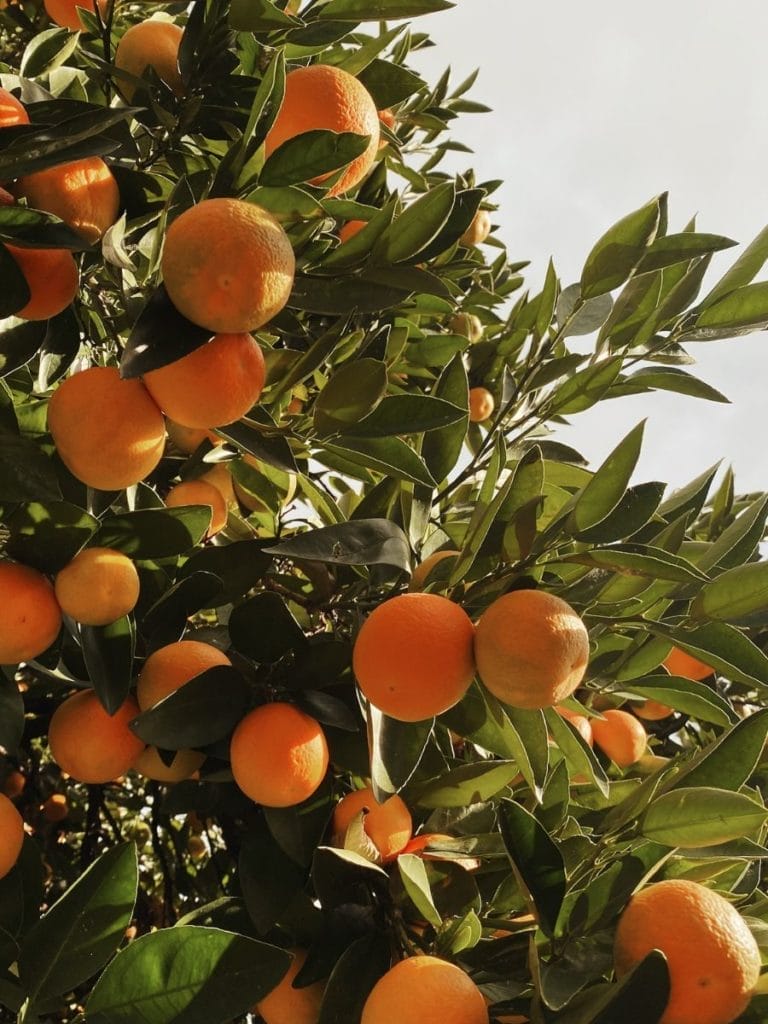
Legend and the Orange Trees
But why orange trees? That’s where legend enters the story. Tradition says that Saint Dominic, founder of the Dominican Order, brought an orange tree from Spain in the 13th century and planted it beside the nearby Basilica of Santa Sabina. According to legend, this was the first orange tree in the area, marking the beginning of orange cultivation and its cultural significance.
This “miraculous” tree is said to have survived for centuries. In fact, it still exists today, but not inside the Orange Garden itself. To catch a glimpse, you need to peer through a small oval window in the cloister of Santa Sabina.
The story goes that whenever the tree dried out, another would sprout from its roots. Its fruit even had a special role: in the 14th century, Saint Catherine of Siena prepared candied oranges from it as gifts for Pope Urban VI. And in 1936, during renovation works, a 14th-century coin was discovered among its roots, only adding to the sense of mystery.
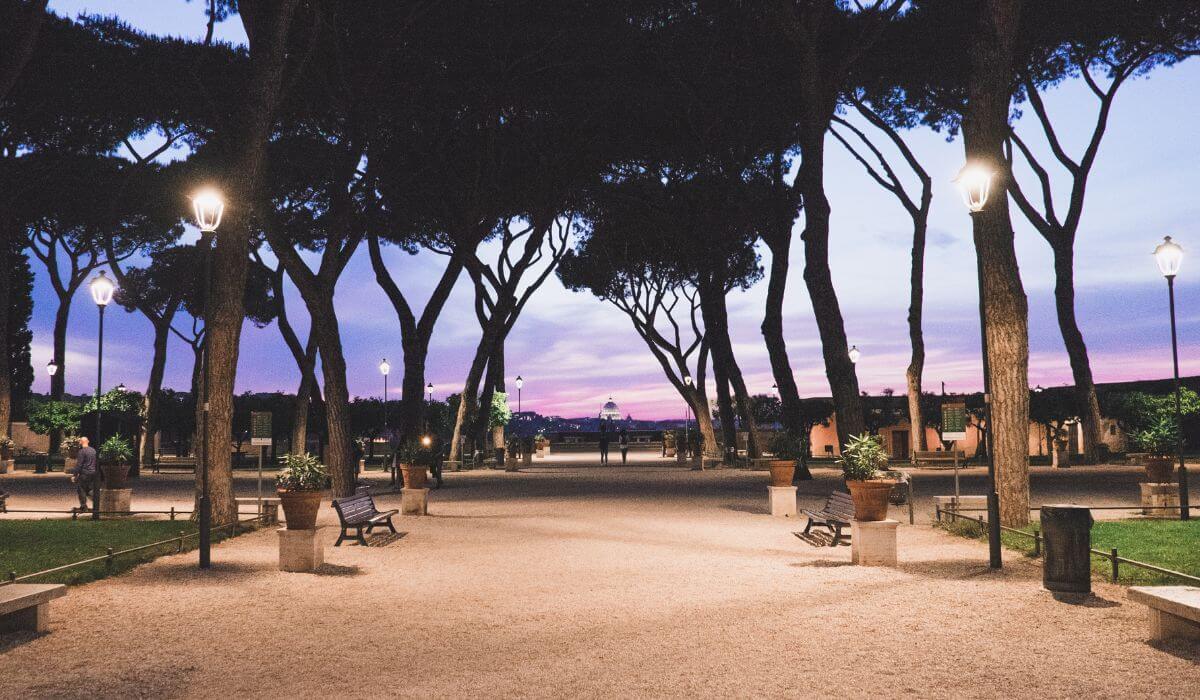
A Place of Memory and Legend
So while most visitors know the Orange Garden as one of Rome’s best sunset viewpoints, it’s also a place layered with history. Between the remains of the Savelli fortress, the Dominican heritage, and the legend of the miraculous orange tree, Parco Savello is more than a garden with a view, it’s where the past and present of Rome meet.
Must-See Places Near the Orange Garden in Rome
The Orange Garden in Rome is already a gem, but the Aventine Hill and its surroundings are packed with other landmarks that are just as fascinating. If you’ve made it up here, don’t miss these highlights:
- Basilica of Santa Sabina – Right across from the garden, this 5th-century paleochristian church is one of Rome’s most important religious sites. This historic building is plain on the outside but breathtaking inside, featuring beautifully carved cypress wood doors and intricate marble floors. It houses the legendary orange tree of Saint Dominic and offers a glimpse into Aventine's long history.
- Aventine Keyhole (Keyhole of the Knights of Malta) – Just a short walk from Parco Savello, peek through the keyhole of the Priory of the Knights of Malta. The door itself is a notable architectural element, and its keyhole creates an iconic Rome optical illusion, perfectly framing the dome of St. Peter’s with hedges, one of the city’s most Instagrammable secrets.
- The Pyramid of Cestius – One of Rome’s quirkiest monuments, this real Egyptian-style pyramid was built in the 1st century BC as the tomb of Caius Cestius. At 36 meters high, it’s a surprising sight to stumble upon in the middle of the city.
- The Municipal Rose Garden (Roseto Comunale) – On your way down toward the Circus Maximus, stop by this garden with more than 1,100 varieties of roses. In spring, when everything is in full bloom, it’s one of the prettiest spots in Rome, and the nearby pine trees provide a cool, shaded ambiance.
- The Protestant Cemetery – Next to the pyramid, this peaceful cemetery is the resting place of English poets John Keats and Percy Bysshe Shelley. A moving and atmospheric stop, especially for literature lovers.
- Circus Maximus (Circo Massimo) – At the foot of the Aventine lies the gigantic stadium where Roman chariots once thundered around the track. With space for up to 250,000 spectators, it was the largest stadium in the ancient world. Today, it’s an open park used for walks, concerts, and events, with archaeological remains still visible.
- The Palatine Hill – Another of Rome’s legendary seven hills, the Palatine is dotted with the ruins of imperial palaces. From here, you can continue directly into the Roman Forum and Colosseum for the ultimate ancient Rome experience.
- Testaccio Neighborhood – Known for its authentic, down-to-earth vibe, Testaccio is the place to go after your Aventine stroll. Grab a plate of true Roman carbonara, cacio e pepe, or amatriciana in one of its traditional trattorias.
Other notable churches on the Aventine Hill, such as St. Alexius, also showcase the area’s rich Christian heritage and remarkable architecture.
FAQ about the Orange Garden in Rome

Is entry to the Orange Garden free?
Yes! Access to the Orange Garden in Rome is completely free. It’s one of those magical places where you can soak in a breathtaking panorama of the Eternal City without spending a single euro.
Can you have a picnic in the Orange Garden?
Officially, the garden is meant for strolling and relaxing, not for picnicking. That said, you’ll often see people enjoying a quick sandwich on a bench or sharing gelato while admiring the view. As long as you’re respectful of the space and leave no trash behind, it’s perfectly fine.
How much time do you need to visit the Orange Garden?
Plan about 30 to 45 minutes to walk around and enjoy the views. If you want to linger a bit longer, maybe wait for the sunset at the Orange Garden in Rome or relax under the trees, set aside about an hour.
Where can you take the best photos of the Orange Garden in Rome?
The most stunning shots are from the panoramic terrace, especially at sunset when the city is bathed in golden light. For a different vibe, go early in the morning when the light is soft and there are fewer people.
How do you get to the keyhole from the Orange Garden?
It couldn’t be easier. Exit the garden through Via di Santa Sabina and walk a few minutes to Piazza dei Cavalieri di Malta. There you’ll find the famous keyhole of the Knights of Malta, where the dome of St. Peter’s Basilica is perfectly framed by the hedges. Since it’s just steps away, plan to visit both together.
Is the Orange Garden romantic?
Absolutely! In fact, it’s one of the favorite spots for Roman couples to watch the sunset. If you’re in Rome with your partner, the Orange Garden is a must for a truly romantic moment.
Fanny is a music and travel lover who has been visiting Rome since 2012. She is the founder and main editor of the Roma Pass blog and she like to share the best things to do in Rome.
